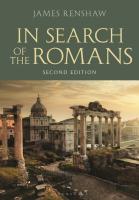
Bloomsbury (2020, 2nd ed.) p/b 450pp £19.99 (9781474299916)
This book is an account of Roman civilisation encompassing history, culture and Empire. The first two chapters are a narrative history from Rome’s mythical beginnings to the fifth century AD. R. deals with the period of the kings and the early Republic by summarising the archaeology and the literary tradition. He then presents both on opposite sides of two chronological tables.
By the middle of the third century, there are some hard facts into which the author can sink his teeth. He does so with gusto. The Punic Wars, Hellenisation, the Senate, magistracies, assemblies, the role of equestrians, the Gracchi, Marius and Sulla, Catiline’s conspiracy, the two triumvirates and the demise of the Republic are all covered in a clear, logical sequence. The evolution of Roman culture is woven into the narrative.
Moving on to the Principate, Augustus is probably the single most important character in the whole of Roman history. R. recognises this by devoting 20 pages (15% of the historical section of the book) to the Augustan era: he covers the constitutional and military reforms, the imperial building programme, the literature which this period inspired, and even Augustus’ private life. R.’s challenge is to condense a vast subject matter into a tight word limit. He effectively summarises the Aeneid in one ‘box’. Inevitably, he deals with the subsequent emperors more concisely. But there is still plenty of detail, especially on the Julio-Claudian dynasty and the Flavians. After that he structures imperial history by centuries. This is possible because—by good fortune—each century has its own special character: the general stability of the second century; the crises of the third century; the fourth century dominated by Constantine’s restructuring of the Empire and by his dynasty. Even more conveniently, the fall of the Western Empire starts at the beginning of the fifth century and culminates in the surrender of Romulus Augustulus to Odoacer in AD 476.
Having covered the entirety of Roman history in 132 pages, R. then discusses ‘Running an Empire’. This chapter describes the Roman army in some detail, as well as the administration of the provinces: provincial government was generally better under emperors than under the Republic. There are accounts of the great revolts of Judaea and Britain, the latter led by Boudica. Interestingly, both occurred in the same decade. R. devotes a section to building techniques and infrastructure, which he illustrates with diagrams, photographs and a handy little map of the Empire. For readers of a certain age, a slightly larger map extending over two adjacent pages would be appreciated.
There then follow chapters on Roman religion, Roman society, entertainment and leisure. The religion chapter is wide ranging. R. deftly contrasts ancient with modern religions. This chapter covers the Etruscan origins of major Roman gods, the impact of Greek culture, the arrival of new gods from the provinces, the deification of emperors, festivals, priesthoods, Mithraism and Christianity. There is even a section on philosophy: the two schools discussed are stoicism and epicureanism. That leads us to Seneca, the most famous Roman stoic, and Lucretius, the Epicurean author of de rerum natura. The chapter on family and social life includes a description of houses, as well as family structure and education. Some aspects of Roman entertainment are familiar to the modern reader, such as comedy and tragedy. Other forms of entertainment such as gladiatorial combat or public executions now seem incomprehensible.
The final two chapters are on Pompeii and Herculaneum. R.’s account of Vesuvius’s eruption combines what we learn from ancient authors, in particular Pliny the Younger, with modern scientific knowledge. Finally, there is a section on the Villa of the Papyri in Herculaneum. This has only partially been excavated. It holds the tantalising prospect of yielding up some of the lost classical texts.
Written with vivid clarity, this book assumes no prior knowledge. It provides the perfect introduction for anyone studying the Roman world. There are plentiful maps, tables and illustrations. The book is punctuated with suggestions for further reading and exercises: e.g. ‘How might history have been different if the Carthaginians had won the Punic Wars?’ (Quite an interesting question!) The author, who is an experienced classics teacher, clearly has the classroom in mind. But this book is far more than a primer for students. It is packed with interesting details, many of which this reviewer has either forgotten or never knew. It has much to offer both classicists and general readers.
Rupert Jackson
